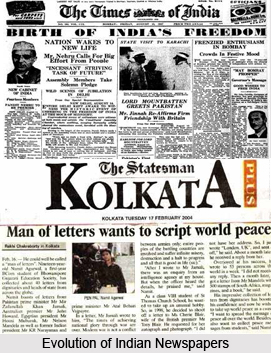 History of Indian Press accounts for the prestigious growth of Indian newspapers and its significance in Indian history as well.
History of Indian Press accounts for the prestigious growth of Indian newspapers and its significance in Indian history as well.
James Augustus Hickey is considered as the "father of Indian press" as he started the first Indian newspaper from Calcutta, the `Bengal Gazette` or the `Calcutta General Advertise` in January 1780. In 1789, the first newspaper from Bombay, the `Bombay Herald` appeared, followed by the `Bombay Courier` next year. This newspaper was later amalgamated with the `Times of India` in 1861.
The first newspaper in an Indian language was in Bengali, named as the `Samachar Darpan`. The first issue of this daily was published from the Serampore Mission Press on May 23, 1818. In the very same year, Ganga Kishore Bhattacharya started publishing another newspaper in Bengali, the Bengal Gazetti. On July 1, 1822 the first Gujarati newspaper was published from Bombay, called the Bombay Samachar, which is still extant. The first Hindi newspaper, the Samachar Sudha Varshan began in 1854. Since then, the prominent Indian languages in which newspapers have grown over the years are Hindi, Malayalam, Marathi, Tamil, Urdu, Telugu, and Bengali.
The status of Indian language papers have taken over the English press according to the latest NRS survey of newspapers. The main reasons include the marketing strategy followed by the regional papers, beginning with Eenadu, a Telugu daily started by Ramoji Rao. The second reason has been the growing literacy rate. Increase in the literacy rate had a direct positive effect on the rise of circulation of the regional papers. The introduction of mother tongue in the primary education stage brought about a great change. The people who learned their mother tongue at the least could read the regional newspapers fluently and thus became aware of the national and regional scenario. During this developmental period, sale of the regional paper in the respective state rose to a great limit.
Indian regional newspapers have several editions for a particular state for complete localisation of news for the reader to connect with the paper. Malayala Manorama has about 10 editions in Kerala itself and six others outside Kerala. Thus regional papers aim at providing localised news for their readers. Even the advertisers saw the huge potential of the regional paper market, partly due to their own research and more due to the efforts of the regional papers to make the advertisers aware of the huge market.
With a long history behind, Indian press has evolved with a supreme power in the contemporary times, where participation of press gives any incident a special value.




















